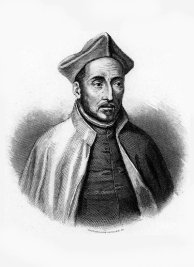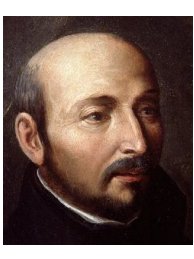Ignatius and Ignatian Spirituality
The Month of Individually Guided Prayer is inspired by the Spiritual Exercises that Ignatius of Loyola wrote between 1522 and 1524. Below is some brief contextual information about Ignatian Spirituality and a short account of the life of Ignatius.
Ignatian Spirituality
The position of Ignatian spirituality in the English speaking world has changed radically over the last 30 years. Interest in the Spiritual Exercises has shifted in focus from the theoretical to the experiential. Consequently, the presentation of the Exercises has become more flexible, concentrating on the needs of the individual retreatant rather than on Ignatian doctrine. Together this has led to the Exercises being available to a much wider range of people outside of the Roman Catholic Church.
That said many people from outside of the Roman Catholic faith are still daunted when they encounter Ignatius for the first time. But when we come to glimpse the real Ignatius of Loyola, we find a man of the early 16th Century who loved life and lived it to the full. Like St. Francis of Assisi, Ignatius took a delight in nature and of God's creation. He had a strong missionary calling and cared passionately for the sick, the poor, and the ordinary person. His values were the values of the Gospel and his sole aim was to do God's will.
Despite this, the word "Ignatian" has become something of a cult word – as if this particular area of spirituality originated with just one man. The reality is somewhat different. Ignatius embarked on a personal spiritual journey with God, recording his own experiences in the Spiritual Exercises in order to help others with their one to one journey with the Lord. But of course, in his own spiritual journey, Ignatius called upon techniques that already existed within older Church traditions. For example, “imaginative contemplation” is used throughout the Spiritual Exercises, but Ignatius learnt this type of prayer from a Carthusian called Ludolf of Saxony. In the preface of his book “Vita Christi”, Ludolf acknowledges that he copied this way of praying from the work of an anonymous Franciscan. Other sources also show that the Twelfth Century Cistercian, Aelred of Rievaulx, and an Eleventh Century Benedictine Archbishop of Canterbury known as Anselm, also taught this method of prayer. It is important to be aware that a central part of “Ignatian” prayer actually comes from a long pedigree which pre-dates Ignatius himself. Accordingly, when looking at Ignatian spirituality, while we need to appreciate the legacy of St. Ignatius of Loyola, we need to see the Exercises as part of the great tradition of the Christian Church.
Ignatius the Man
Though it is important to highlight the role of other long established traditions in the creation of Ignation Spirituality, it is also useful to establish a history of the man himself. (This short account of Ignatius’ life also highlights certain other events that were taking place in the world at the time).
Inigo Lopez was born in 1491 and was raised in privilege at the castle of Loyola. (Interestingly, he actually took the name Ignatius 40 years later when at University in Paris). His family were one of twenty four noble families, fervent in their loyalty to the Basque region and the crown of Ferdinand and Isabella. Inigo was the youngest of 6 brothers and 4 sisters. His mother, Maria, died before he was 7. From that time Inigo was raised by his sister-in-law, whom he adored. He grew up a true Basque – wild, head strong and passionate. He loved life, especially dancing and women.
- 1491 Henry VIII born
- 1492 Columbus reaches the West Indies
- 1498 Da Gama reaches India via the Cape
When, in 1506, Inigo was 15 he became a page in the household of the master of the royal treasury. He spent 10 years here before his master was disgraced and Inigo had to transfer to serve in another court. His early years were characterized by a joy of living. His constant dream was to do great things, to acquire as much glory as he could (especially in the military world) and, at the same time, to enjoy his women! His contemporaries describe how he was "reckless at games, in adventures with women, in brawls and deeds of arms… [and how he] …was assailed and overcome by temptations of the flesh"
- 1509 Henry VIII crowned King and John Calvin is born
In 1521 Inigo was at war, defending the town of Pamplona, against the French. The garrison was on the point of surrender, but for Inigo's insistence they fought on. Then, on Whit Monday, Inigo suffered a direct hit from a French canon ball that shattered his leg. The garrison subsequently surrendered. Inigo was cared for by the French for two weeks before being returned home to Loyola to be looked after by his sister-in-law.
- 1521 Martin Luther is excommunicated
Soon his leg bone set, but it was crooked and Inigo was afraid that it would look unsightly in silk trousers. He insisted that it was broken again and reset. This procedure took place without anaesthetic and nearly killed him. Though he received the Last Sacraments during this time, he slowly began a long path to recovery.
As he began to get better, he was given two books: one on the Life of Christ and another on the lives of the saints. Thus began his conversion. Firstly, the passionate Basque noticed how passionately the saints loved the Lord. His dreams held the other key. During the long hours of convalescence, he had plenty of time to dream. They were essentially of two kinds. The first was directed towards his old life and ambitions: his women, his conquests, and his glory. These dreams were a source of considerable pleasure, but the pleasure did not last. He noticed how he was left feeling tired and depressed. The second kind of dreaming was to do with serving the Lord after the pattern of the saints. This too gave him much comfort and peace of mind. But he noticed that there was a difference in these second dreams – the sense of happiness and well-being stayed with him for a long time afterwards. So he sought to abandon one for the other and to seek in every way to follow Christ. (This was, in fact, the very early stages of his thinking on “discernment”).
Inigo eventually recovered and set off on a donkey, in typically dramatic fashion, with no clearer idea than to beg his way across Spain and go on to Jerusalem. At this stage his conversion meant little more than exchanging "worldly" ambitions for “holy" ones. It was only later he realised that conversion was an ongoing process: a process of deepening, over and over again, for people, for creation and for God who is to be seen and enjoyed in all things.
In 1522 he arrived at the Benedictine Monastery of Montserrat. Where set atop the jagged hills, stood a shrine to Mary. It took Inigo three days to make his confession, but it was here he offered himself wholly to the service of Almighty God. He gave away his clothes bought a pilgrims habit, a rope girdle, some sandals and then set off for Manresa. On arrival he stayed in a Dominican convent and spent much of his time teaching children in the streets and caring for the sick. He found a cave by the side of the river Cardoma. It looked across the river to the high serrated edge of the Montserrat mountains. Here he spent many hours in prayer and meditation.
During this time Inigo let himself go and became unkempt, of poor sight, and very ill. He despaired of himself in this state, but it was in his despair that he received a vision of the Trinity: of the love of God in Creation; of the love of Our Lord, and His redemptive mission. It was probably here that much of the core thinking behind the Spiritual Exercises came into being. The winter of 1522 year saw him near to death once again, but he recovered and planed to continue his journey to Jerusalem. At the beginning of 1523 he journeyed to Rome in order to get permission from Pope Adrian VI to visit the Holy Land. Having got permission, Inigo set off for Venice, and eventually arrived in Jerusalem. But he was not allowed to stay and so returned to Italy vowing to return one day.
Now in his early 30's he still didn't know exactly what he wanted to do except follow the Lord and show others the Christ who had been so real to him. But Inigo realized that he needed to be trained, or he would not be accepted by the Church. So back in Barcelona, at the age of 33, he enrolled at the University of Alcala. Throughout this time he begged for food, lived with the poor, and gave spiritual direction. But because he wasn't trained the Inquisition threw him in prison on suspicion of heresy. He was later to be found innocent but was forbidden to give direction on spiritual matters. Instead, he moved to the University of Salamanca, and there fell foul of the authorities again and, once more, was imprisoned. Finally he went to Paris, together with a few companions, to complete his training. Finance was now a great problem and he even came over to London on a begging trip. Later Ingio found a benefactor, completed his studies, and received a Masters degree. It was now that he changed his name to Ignatius after the second century martyr.
In Paris he gathered around him six young men, all of whom he gave the Spiritual Exercises. This group were to form the embryo of the Society of Jesus. At the end of their studies they all made vows of poverty and chastity at the little chapel of the Martyrs in Montmartre. In 1534 they set out for Rome and the Holy Land. They were eventually ordained in 1536.
- 1536 First edition of John Calvin's “Institutes of the Christian Religion”
The Society of Jesus was founded in 1539/40, it was a missionary community that travelled the world and that today is among the largest of the Communities of the Catholic Church
- 1545 Council of Trent
- 1546 Martin Luther dies
- 1547 Henry VIII dies
Ignatius died in 1556
Text edited from material written by Will Thompson.
